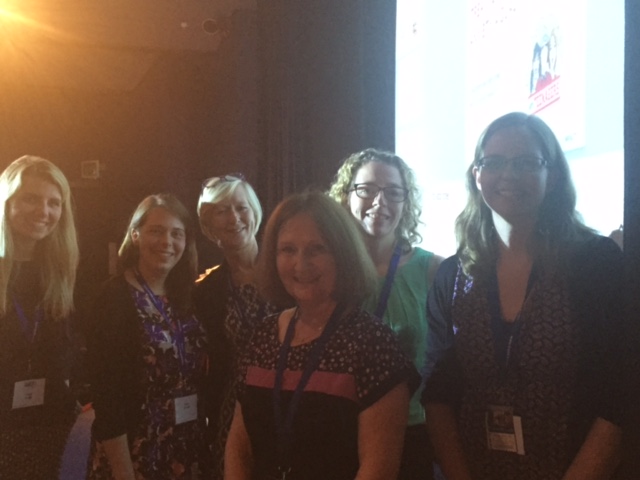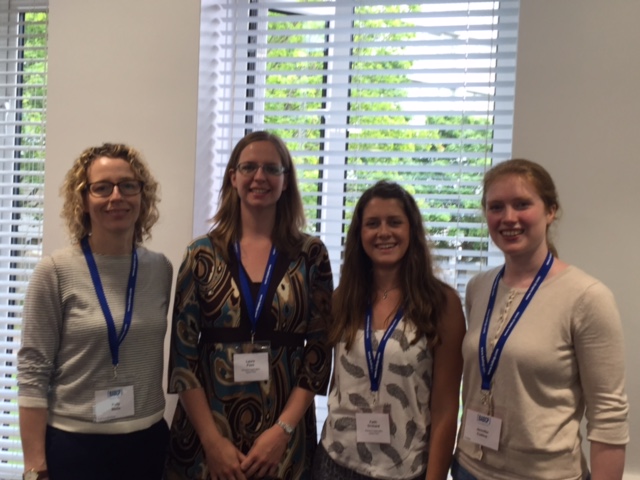British Association for Behavioural and Cognitive Psychotherapies (BABCP) Annual Conference
Last month some of our AnDY team had the fantastic opportunity to attend the BABCP conference, held at the University of Warwick. Located on a great campus, the conference gave us the chance to meet fellow researchers and hear about the interesting research being carried out. Importantly it
also allowed us to share the work we do at AnDY with others. Our team was part of symposiums, skills classes, poster presentations and debates.
On the first morning of the conference Shirley and Laura had the chance to run a Skills Class on adapting Behavioural Activation (BA) for adolescent depression. The Skills Class was very well attended and stimulated some very interesting discussions about the BA approach. A number of clinicians are working in adult services, so the key aspects of adapting BA for young people were of particular relevance (e.g. engagement, working with parents, and consideration of developmental issues such as ongoing cognitive development).
Following on from this, Polly, Katie, Lydia, Laura and Shirley were all part of an interesting symposium titled “Improving our treatment of Anxiety and Depression”. We know that approximately 5% of British 13-15 year olds are diagnosed with anxiety and 2.5% with depression. We also know that as children move into adolescence, anxiety disorders become more common and severe, and often come hand in hand with depressive symptoms. Depression in teenagers has also been shown to be highly comorbid with anxiety, behavioral problems, is a major risk factor for suicide and has many long term negative impacts on a young person’s future. Therefore finding effective, early treatments for these disorders is essential!
Our team spoke alongside Sue Spence, a highly respected Professor who specializes in adolescent anxiety and depression. Sue came all the way from Australia to discuss her work on BRAVE. BRAVE is an online CBT treatment that, with therapist support, has been found to be effective when delivered to adolescents in Australia (Spence et al, 2011).
Polly gave an excellent presentation, also discussing the internet program BRAVE. We heard about the results of the randomised control trial that involved adolescents referred to CAMHS who took part in the internet program (BRAVE online plus therapist support). She reported that the program was effective, however many adolescent are still symptomatic at the end of treatment. Polly concluded that we need to better understand the key components of treatment and who it works best for.
Katy and Lydia followed on from Polly. They spoke about their very recent MSc projects, looking at parent and adolescent experiences of BRAVE. There hasn’t been much research into patient perspectives of treatments, particularly those of young people. Yet, we know that understanding patient experiences is really valuable for improving and designing new interventions and services. During the interviews with parents 4 main themes emerged: Acceptability of BRAVE, observations since completing BRAVE, value of the therapist, and parental involvement. Following the interviews with adolescents, four key themes were identified from the data, including adolescent perspectives on the design of BRAVE (for example, the idea of a treatment being delivered online and whether the program was age appropriate), opinions regarding specific aspects of the program such as relaxation and rewards, the outcomes of BRAVE, as well as potential options for improving the program. If you would like to hear more about the results, please read our more detailed blog about Lydia and Katy’s projects. We would also like to say a huge well done to the girls as this was their first ever conference presentation!
Turning to depression, Laura gave an engaging talk discussing Behavioural Activation (BA) for adolescents, she explained the background to our work on adapting BA for teenagers and discussed the evidence for this approach being effective with adults, and the rationale for adapting it to use with adolescents. Laura also presented some pilot data on the cases we’ve seen so far, which suggests high levels of engagement and satisfaction with the BA treatment from both young people and parents, as well as equivalent outcomes to CBT, which is currently the standard treatment offered. This pilot data is extremely positive and we are excited to see what the future holds for BA! Shirley finished this symposium with discussions about improving mood with psychodynamic and cognitive therapies.On the same day, in a different symposium, Cathy discussed Cognitive Behaviour Therapy as an effective treatment for anxiety disorders in children. However, she pointed out that many children who would benefit from this approach are not able to access it. Cathy and colleagues developed a way of delivering CBT efficiently and effectively via parents (Guided Parent-Delivered CBT; GPD-CBT) and have found that many children achieve excellent outcomes following this approach. Cathy presented data from a recent study in which they compared this brief treatment to an alternative brief talking therapy (Solution Focused Brief Therapy; SFBT). They found that both treatments achieved good outcomes however the cost of delivering treatment was significantly less for GPD-CBT than for SFBT. The findings have exciting implications for increasing access to evidence based treatments for children with anxiety disorders.
In a separate symposium, Brynjar discussed his research regarding ‘reassurance seeking’. Seeking reassurance from other people is probably the most common interpersonal reaction to feelings of anxiety or distress. Additionally, reassurance can become very complex, persistent, extensive, debilitating and may dominate the interactions of those involved. The research Brynjar presented suggests that sufferers of anxiety problems and their loved ones find it very hard to manage reassurance seeking and giving. The research has also identified that the current clinical recommendations for how to treat excessive reassurance seeking may not be helpful. In light of this, Brynjar and colleagues are researching new treatment interventions that are aimed at overcoming the existing obstacles in treating excessive reassurance seeking within the context of anxiety problems.
On Friday morning, Polly, Faith, Laura and Jen all presented in another fantastic symposium: Cognitive and family factors in anxiety and depression in adolescence. The recommended treatment for anxiety and depression in young people is Cognitive Behavioural therapy (CBT) however the research behind this approach for teenagers is much more limited compared to adult work. CBT aims to help people challenge their biased cognitions (thoughts) and to think in a more realistic way. The purpose of the symposium was to gain a greater understanding of anxiety and depression in terms of cognitions (how we think about things) and parent behaviour, which might maintain teenagers anxiety and/or depression symptoms.
Polly began by discussing interpretation biases in anxious adolescents. Polly explained that key aspects of the adult cognitive models in anxiety are applicable to adolescents, however this does not seem to be the case for children younger than 10. It is clear that treatment focusing on addressing interpretation biases and avoidance are warranted in adolescents.
Laura also presented work on interpretation biases (interpretation of ambiguous scenarios, and neutral sounds), however, this time in adolescent depression. The data is being conducted as part of Faith’s PhD. The findings suggest that depressed adolescents do have interpretation biases regarding ambiguous information, as well as a negative bias towards neutral sounds, compared to adolescents without low mood. Faith then went on to discuss the memory biases also investigated with this sample. Her main findings currently are that adolescents with depression demonstrate biased positive, but not negative, memories compared with non-depressed adolescents. That data also suggests that depressed teenagers recall less positive information, and give less specific information when asked to describe positive memories.
To complete the symposium, Jen Collins gave a splendid talk about her study. Jen examined parental expressed emotion in the context of adolescent anxiety and mood disorders, in comparison to a non-clinical control group. Expressed emption is often used in child and adolescent research as a measure of emotional attitudes and feelings expressed by a family member towards the young person with mental health difficulties. Jen’s results indicated higher levels of parental self-sacrificing behaviour, and lower levels of positivity, in the parental expressed emotion of the clinical groups compared to controls. The study highlighted the need to continue developing how expressed emotion is investigated in adolescent populations, in order to capture meaningful data.
Overall the conference was a huge success and, let’s not forget, lots of fun! Alongside sharing our research and ideas we enjoyed a BBQ at Warwick castle, and had a great Spanish themed last night, with tapas and salsa dancing! As a team we would like to say a huge thank you to the organizers for all their hard work and making sure the conference ran as smoothly as it did! Please keep watching for more detailed blogs, such as Suzannah’s poster presentation and Lydia and Katy’s Msc projects!



